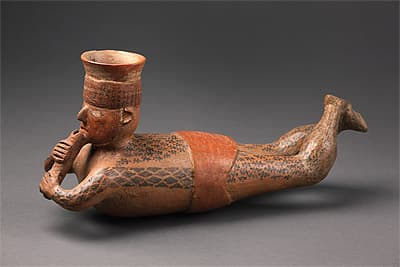
CHINCHA culture South coast 1100 – 1476 AD
Vessel in the form of a musician 1100-1476 AD ceramic15.0 (h) x 8.5 (w) x 32.0 (d) cm Ministerio de Cultura del Perú: Museo Nacional de Arqueología, Antropología e Historia del Perú, Photograph: Daniel Giannoni
A somewhat stout musician lies on his front, blowing into his flute. It can be identified by its notched end as an upright kena.1 His hat serves as the vessel’s neck, its textile band echoed in his orange loincloth. As well as the relaxed pose of the man’s legs, the ceramic is notable for the naturalistic skin tones achieved by the fired clay. The vessel was probably a silbadora (whistling pot), which produced sound as it was blown into or poured from.
Black skin markings, presumably of ritual or tribal significance, run down his arms and legs, and decorate his back. These are either temporary—body paint—or permanent tattoos or skin stitching. Such marking can be seen in Nazca ceramics (cat. 51) and is also known in Chimú culture. Here they may relate to the Chincha worship of the jaguar deity.
The cultures of the south coast, such as Ica and Chincha—sometimes combined as Ica-Chincha—flourished after the fall of the Huari Empire in the eleventh century. They benefited from Huari advances in agriculture, especially irrigation and terracing for crops, and artistically were strongly influenced by their predecessors. Burial practices such as ceramic and textile grave goods accompanying the important dead continued, although how often the objects were used in ceremonial and everyday life is not established. The Chincha culture was finally vanquished by the Inca Empire by 1476.
Christine Dixon
1. Craig Morris and Adriana von Hagen, The Inka Empire and its Andean origins, New York: Abbeville Press 1993, p. 207.
A somewhat stout musician lies on his front, blowing into his flute. It can be identified by its notched end as an upright kena.1 His hat serves as the vessel’s neck, its textile band echoed in his orange loincloth. As well as the relaxed pose of the man’s legs, the ceramic is notable for the naturalistic skin tones achieved by the fired clay. The vessel was probably a silbadora (whistling pot), which produced sound as it was blown into or poured from.
Black skin markings, presumably of ritual or tribal significance, run down his arms and legs, and decorate his back. These are either temporary—body paint—or permanent tattoos or skin stitching. Such marking can be seen in Nazca ceramics (cat. 51) and is also known in Chimú culture. Here they may relate to the Chincha worship of the jaguar deity.
The cultures of the south coast, such as Ica and Chincha—sometimes combined as Ica-Chincha—flourished after the fall of the Huari Empire in the eleventh century. They benefited from Huari advances in agriculture, especially irrigation and terracing for crops, and artistically were strongly influenced by their predecessors. Burial practices such as ceramic and textile grave goods accompanying the important dead continued, although how often the objects were used in ceremonial and everyday life is not established. The Chincha culture was finally vanquished by the Inca Empire by 1476.
Christine Dixon
1. Craig Morris and Adriana von Hagen, The Inka Empire and its Andean origins, New York: Abbeville Press 1993, p. 207.
A somewhat stout musician lies on his front, blowing into his flute. It can be identified by its notched end as an upright kena.1 His hat serves as the vessel’s neck, its textile band echoed in his orange loincloth. As well as the relaxed pose of the man’s legs, the ceramic is notable for the naturalistic skin tones achieved by the fired clay. The vessel was probably a silbadora (whistling pot), which produced sound as it was blown into or poured from.
Black skin markings, presumably of ritual or tribal significance, run down his arms and legs, and decorate his back. These are either temporary—body paint—or permanent tattoos or skin stitching. Such marking can be seen in Nazca ceramics (cat. 51) and is also known in Chimú culture. Here they may relate to the Chincha worship of the jaguar deity.
The cultures of the south coast, such as Ica and Chincha—sometimes combined as Ica-Chincha—flourished after the fall of the Huari Empire in the eleventh century. They benefited from Huari advances in agriculture, especially irrigation and terracing for crops, and artistically were strongly influenced by their predecessors. Burial practices such as ceramic and textile grave goods accompanying the important dead continued, although how often the objects were used in ceremonial and everyday life is not established. The Chincha culture was finally vanquished by the Inca Empire by 1476.
Christine Dixon
1. Craig Morris and Adriana von Hagen, The Inka Empire and its Andean origins, New York: Abbeville Press 1993, p. 207.

